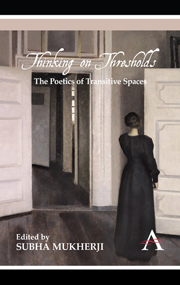42 results

Thinking on Thresholds
- The Poetics of Transitive Spaces
-
- Published by:
- Anthem Press
- Published online:
- 05 March 2012
- Print publication:
- 15 February 2011
Part Three - Matter, Mind, Psyche
-
- Book:
- Thinking on Thresholds
- Published by:
- Anthem Press
- Published online:
- 05 March 2012
- Print publication:
- 15 February 2011, pp 129-130
-
- Chapter
- Export citation
Part Two - Lives and Narratives, Territories and Worlds
-
- Book:
- Thinking on Thresholds
- Published by:
- Anthem Press
- Published online:
- 05 March 2012
- Print publication:
- 15 February 2011, pp 71-72
-
- Chapter
- Export citation
Introduction
-
-
- Book:
- Thinking on Thresholds
- Published by:
- Anthem Press
- Published online:
- 05 March 2012
- Print publication:
- 15 February 2011, pp xvii-xxviii
-
- Chapter
- Export citation
4 - ‘Invasion from Outer Space’: The Threshold of Annunciations
- from Part One - Doors, Windows, Entries
-
-
- Book:
- Thinking on Thresholds
- Published by:
- Anthem Press
- Published online:
- 05 March 2012
- Print publication:
- 15 February 2011, pp 43-70
-
- Chapter
- Export citation
Part One - Doors, Windows, Entries
-
- Book:
- Thinking on Thresholds
- Published by:
- Anthem Press
- Published online:
- 05 March 2012
- Print publication:
- 15 February 2011, pp 1-2
-
- Chapter
- Export citation
Select Bibliography (including Discography)
-
- Book:
- Thinking on Thresholds
- Published by:
- Anthem Press
- Published online:
- 05 March 2012
- Print publication:
- 15 February 2011, pp 213-224
-
- Chapter
- Export citation
Part Four - Reading, Writing, Playing, Listening
-
- Book:
- Thinking on Thresholds
- Published by:
- Anthem Press
- Published online:
- 05 March 2012
- Print publication:
- 15 February 2011, pp 155-156
-
- Chapter
- Export citation
Notes on Contributors
-
- Book:
- Thinking on Thresholds
- Published by:
- Anthem Press
- Published online:
- 05 March 2012
- Print publication:
- 15 February 2011, pp xiii-xvi
-
- Chapter
- Export citation
Frontmatter
-
- Book:
- Thinking on Thresholds
- Published by:
- Anthem Press
- Published online:
- 05 March 2012
- Print publication:
- 15 February 2011, pp i-vi
-
- Chapter
- Export citation
ACKNOWLEDGEMENTS
-
- Book:
- Thinking on Thresholds
- Published by:
- Anthem Press
- Published online:
- 05 March 2012
- Print publication:
- 15 February 2011, pp vii-viii
-
- Chapter
- Export citation
Contents
-
- Book:
- Thinking on Thresholds
- Published by:
- Anthem Press
- Published online:
- 05 March 2012
- Print publication:
- 15 February 2011, pp ix-x
-
- Chapter
- Export citation
List of Illustrations
-
- Book:
- Thinking on Thresholds
- Published by:
- Anthem Press
- Published online:
- 05 March 2012
- Print publication:
- 15 February 2011, pp xi-xii
-
- Chapter
- Export citation
Frontmatter
-
- Book:
- Early Modern Tragicomedy
- Published by:
- Boydell & Brewer
- Published online:
- 12 September 2012
- Print publication:
- 15 November 2007, pp i-iv
-
- Chapter
- Export citation
Acknowledgements
-
- Book:
- Early Modern Tragicomedy
- Published by:
- Boydell & Brewer
- Published online:
- 12 September 2012
- Print publication:
- 15 November 2007, pp vii-vii
-
- Chapter
- Export citation
Index
-
- Book:
- Early Modern Tragicomedy
- Published by:
- Boydell & Brewer
- Published online:
- 12 September 2012
- Print publication:
- 15 November 2007, pp 209-216
-
- Chapter
- Export citation
Contents
-
- Book:
- Early Modern Tragicomedy
- Published by:
- Boydell & Brewer
- Published online:
- 12 September 2012
- Print publication:
- 15 November 2007, pp v-vi
-
- Chapter
- Export citation
Studies in Renaissance Literature
-
- Book:
- Early Modern Tragicomedy
- Published by:
- Boydell & Brewer
- Published online:
- 12 September 2012
- Print publication:
- 15 November 2007, pp 217-218
-
- Chapter
- Export citation
Notes on Contributors
-
- Book:
- Early Modern Tragicomedy
- Published by:
- Boydell & Brewer
- Published online:
- 12 September 2012
- Print publication:
- 15 November 2007, pp viii-x
-
- Chapter
- Export citation
Introduction
-
-
- Book:
- Early Modern Tragicomedy
- Published by:
- Boydell & Brewer
- Published online:
- 12 September 2012
- Print publication:
- 15 November 2007, pp 1-14
-
- Chapter
- Export citation



